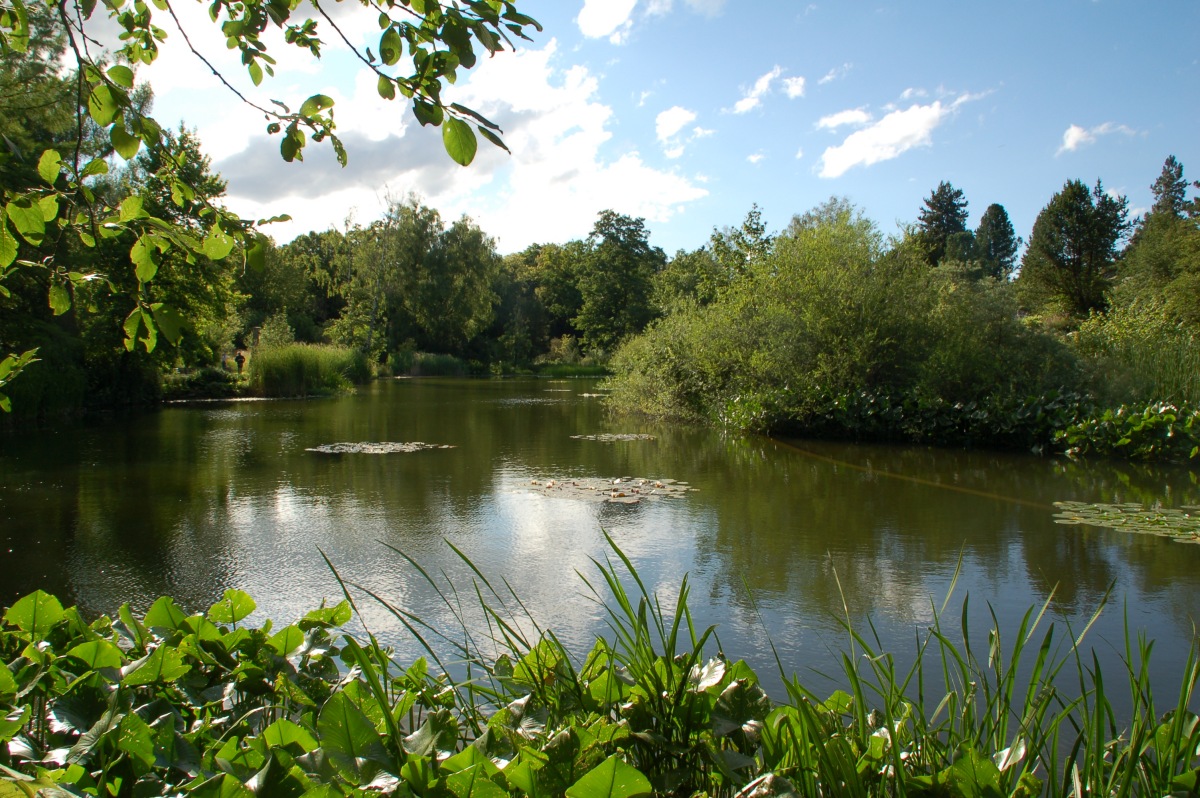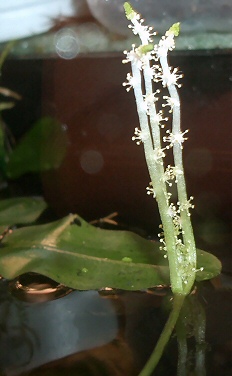|
Aponogeton Capuronii
''Aponogeton capuronii'' (named after René Paul Raymond Capuron) is an aquatic plant found in southeastern Madagascar. Description ''Aponogeton capuronii'' has a rhizome In botany and dendrology, a rhizome (; , ) is a modified subterranean plant stem that sends out roots and shoots from its nodes. Rhizomes are also called creeping rootstalks or just rootstalks. Rhizomes develop from axillary buds and grow hori ... up to 10 x 2-cm thick. Leaf blade 7–20 cm long petiolate, slightly leathery, 20–40 cm long and 3-4.5(-8) cm wide, flat or highly bullate and undulate, dark olive-green coloring. Apex acute, base round, cuneate or slightly cordate. Peduncle 40-60(-300) cm long, swollen toward the inflorescence. Spathe up to 1.5 cm long, caducous. Inflorescence with 2, seldom 3 up to 14 cm long spikes with omnilateral flowers; 2 white tepals; 6 stamens; 3-4 carpels with 2(-4) ovules each. Fruit about 6x3 mm in size, with a terminal beak. Seeds up to 3.25 x 1.5 ... [...More Info...] [...Related Items...] OR: [Wikipedia] [Google] [Baidu] |
Harry Van Bruggen
Heinrich (Harry) Wilhelm Eduard van Bruggen (December 6, 1927 in Amsterdam – February 8, 2010 in Amersfoort) was a Dutch amateur botanist. Personal life After finishing secondary school, van Bruggen became an accountant, first in his uncle's company, later with Koninklijke Hoogovens, where he became the head of the Administration. In 1950 he married Anna Blom, with whom he had a son; she died in 1996. In April 2000 he remarried with Liesbeth Bakker. Van Bruggen was interested in nature already at a very young age, in particular in animals and plants in and around water. He sowed his first plants when he was 5-years old: ''Tagetes''. This led to his lifelong interest in botany, particularly water and marsh plants and orchids. Van Bruggen was an active member of the "Dutch Waterplant Society", for which he did the administration during many years. Contributions to botany In the late fifties, van Bruggen obtained from an aquarium-plant importer an ''Aponogeton'' species w ... [...More Info...] [...Related Items...] OR: [Wikipedia] [Google] [Baidu] |
René Paul Raymond Capuron
René Paul Raymond Capuron (20 October 1921 – 24 August 1971) was a French botanist. Capuron was responsible for an extensive amount of work on the tree flora of Madagascar. Several tree taxa with the specific epithet of ''capuronii'' honor his name, examples being '' Podocarpus capuronii'' and '' Schizolaena capuronii''. Works Highlights of his work include: *''M. arillata'' — a new species of ''Mauloutchia'', formed from the collection of ''Myristicaceae'' specimens. *''Takhtajania perrieri'' — the only extant representative of the family ''Winteraceae''. Capuron was the first to rediscover the plant, following its last sighting by Henri Perrier de la Bathie, back in 1909. Bibliography *''Essai d'introduction à l'étude de la flore forestière de Madagascar'', Tananarive, ''Inspection Générale des Eaux & Forêts'', 1957, 125 pp. *''Rhopalocarpacées''. In: ''Flore de Madagascar et des Comores'', vol. 127, Paris, 1963, 41 pp. *''Révision des Sapindacées de Madagascar e ... [...More Info...] [...Related Items...] OR: [Wikipedia] [Google] [Baidu] |
Aquatic Plant
Aquatic plants are plants that have adapted to living in aquatic environments (saltwater or freshwater). They are also referred to as hydrophytes or macrophytes to distinguish them from algae and other microphytes. A macrophyte is a plant that grows in or near water and is either emergent, submergent, or floating. In lakes and rivers macrophytes provide cover for fish, substrate for aquatic invertebrates, produce oxygen, and act as food for some fish and wildlife. Macrophytes are primary producers and are the basis of the food web for many organisms. They have a significant effect on soil chemistry and light levels as they slow down the flow of water and capture pollutants and trap sediments. Excess sediment will settle into the benthos aided by the reduction of flow rates caused by the presence of plant stems, leaves and roots. Some plants have the capability of absorbing pollutants into their tissue. Seaweeds are multicellular marine algae and, although their ecologi ... [...More Info...] [...Related Items...] OR: [Wikipedia] [Google] [Baidu] |
Madagascar
Madagascar (; mg, Madagasikara, ), officially the Republic of Madagascar ( mg, Repoblikan'i Madagasikara, links=no, ; french: République de Madagascar), is an island country in the Indian Ocean, approximately off the coast of East Africa across the Mozambique Channel. At Madagascar is the world's List of island countries, second-largest island country, after Indonesia. The nation is home to around 30 million inhabitants and consists of the island of Geography of Madagascar, Madagascar (the List of islands by area, fourth-largest island in the world), along with numerous smaller peripheral islands. Following the prehistoric breakup of the supercontinent Gondwana, Madagascar split from the Indian subcontinent around 90 million years ago, allowing native plants and animals to evolve in relative isolation. Consequently, Madagascar is a biodiversity hotspot; over 90% of wildlife of Madagascar, its wildlife is endemic. Human settlement of Madagascar occurred during or befo ... [...More Info...] [...Related Items...] OR: [Wikipedia] [Google] [Baidu] |
Rhizome
In botany and dendrology, a rhizome (; , ) is a modified subterranean plant stem that sends out roots and shoots from its nodes. Rhizomes are also called creeping rootstalks or just rootstalks. Rhizomes develop from axillary buds and grow horizontally. The rhizome also retains the ability to allow new shoots to grow upwards. A rhizome is the main stem of the plant that runs underground horizontally. A stolon is similar to a rhizome, but a stolon sprouts from an existing stem, has long internodes, and generates new shoots at the end, such as in the strawberry plant. In general, rhizomes have short internodes, send out roots from the bottom of the nodes, and generate new upward-growing shoots from the top of the nodes. A stem tuber is a thickened part of a rhizome or stolon that has been enlarged for use as a storage organ. In general, a tuber is high in starch, e.g. the potato, which is a modified stolon. The term "tuber" is often used imprecisely and is sometimes applied to ... [...More Info...] [...Related Items...] OR: [Wikipedia] [Google] [Baidu] |
Botanischer Garten München-Nymphenburg
The Botanischer Garten München-Nymphenburg (21.20 hectares) is a botanical garden and arboretum located at Menzinger Str. 65, Munich, Bavaria, Germany. It is open daily, except on 24 and 31 December; an admission fee is charged. History Munich's first botanical garden, now called the "old botanical garden", was established in 1809 to designs by Friedrich Ludwig von Sckell near Karlsplatz, where its remains are still visible. The old botanical garden was replaced by a new garden created next to the park of Schloss Nymphenburg in 1912/13 and officially opened on 10 May 1914. The garden was designed by Peter Holfelder (1878–1936) who worked closely with Walter Kupper (1874–1953) and Leonhard Dillis (1871–1946). Description Today the garden cultivates about 19,600 species and subspecies on approximately 18 hectares. Its mission is to provide a beautiful and restful environment as well as educate the public about plants and nature more broadly. Major collections in ... [...More Info...] [...Related Items...] OR: [Wikipedia] [Google] [Baidu] |
Aponogeton
The Aponogetonaceae (the Cape-pondweed family or aponogeton family) are a family of flowering plants in the order Alismatales. In recent decades the family has had universal recognition by taxonomists. The APG system (1998) and APG II system (2003) treat it in the order Alismatales in the clade monocots. The family consists of only one genus, ''Aponogeton'', with 56 known species (Christenhusz & Byng 2016 ) of aquatic plants, most of which have been included in a molecular phylogeny by Chen et al. (2015). The name was published in '' Supplementum Plantarum'' 32: 214 (1782) and is derived from a geographic location neighboring (''geton'') the Apono tribal district of coastal Gabon. Some species are used as ornamental plants in aquariums. Distribution They are aquatic plants, which are found in tropical to warm temperate regions of Africa, Asia and Australasia.Watson, L. & Dallwitz, M. J. (1992 onwards)Aponogetonaceae ''Aponogeton distachyos'' is originally from South Africa but h ... [...More Info...] [...Related Items...] OR: [Wikipedia] [Google] [Baidu] |
Plants Described In 1968
Plants are predominantly photosynthetic eukaryotes of the kingdom Plantae. Historically, the plant kingdom encompassed all living things that were not animals, and included algae and fungi; however, all current definitions of Plantae exclude the fungi and some algae, as well as the prokaryotes (the archaea and bacteria). By one definition, plants form the clade Viridiplantae (Latin name for "green plants") which is sister of the Glaucophyta, and consists of the green algae and Embryophyta (land plants). The latter includes the flowering plants, conifers and other gymnosperms, ferns and their allies, hornworts, liverworts, and mosses. Most plants are multicellular organisms. Green plants obtain most of their energy from sunlight via photosynthesis by primary chloroplasts that are derived from endosymbiosis with cyanobacteria. Their chloroplasts contain chlorophylls a and b, which gives them their green color. Some plants are parasitic or mycotrophic and have lost the ability t ... [...More Info...] [...Related Items...] OR: [Wikipedia] [Google] [Baidu] |




